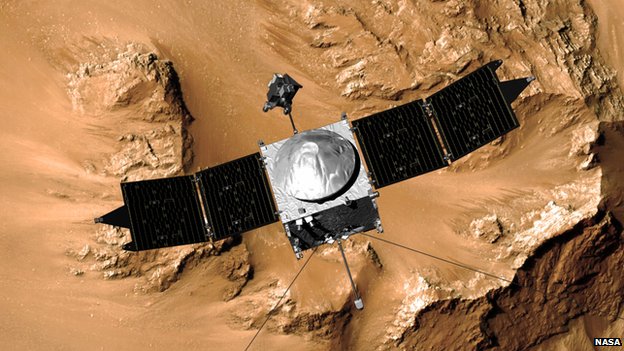Maven spacecraft successfully arrived at Mars orbit

A few days ago, information was published that the Maven machine should arrive shortly into the orbit of the Red Planet, and in order to “cling” to the gravity of Mars, the device needed to perform a rather complicated series of maneuvers. If the maneuver had not been successful, Maven could have simply passed by, in which case the device worth tens of millions of dollars (and invaluable to science) would have been lost. For 10 months since launch, the device has covered 442 million kilometers.
But everything went well. As a result of a 33-minute maneuver, during which the fuel was burned by 6 main engines of the device, the speed was reset to the desired one. For 33 minutes, more than half of the fuel available on board was burned. This allowed the device to enter the orbit of Mars without any problems.
')
Now Maven has become a 35-hour orbit, and within a few weeks, the team of operators, thanks to the completion of another series of maneuvers, will move the device to a 4.5-hour operating orbit. This orbit is quite extended, and the minimum distance to the planet will be 150 km, and the maximum - 6,200 km.

Sometime on the surface of Mars water flowed
In the first few weeks of its presence in Mars orbit, the Maven satellite will test the performance of its scientific instruments (there are nine of them).
The main task of Maven is to study the atmosphere of Mars, to highlight the stages of its evolution. Thanks to the data obtained, scientists will be able to understand how Mars has turned from a rather hospitable planet into a dry desert. Perhaps the satellite will tell you exactly when the atmosphere of Mars began to change, and experts will be able to find out the reason. Perhaps this is the cause of the constant action of the solar wind - Mars does not have a magnetic field like that of the Earth, so the "solar wind" has a strong influence on the planet and its atmosphere.
The main tasks of the apparatus are as follows:
- To determine the influence of external factors on the change of the atmosphere of Mars;
- To determine the current state of the upper atmosphere of the planet, the ionosphere and the interaction of the atmosphere with the solar wind;
- Determine the current volumes of "leakage" of neutral gases and ions into outer space, as well as study the processes that have an impact on the leakage;
- Determine the ratio of stable isotopes in the atmosphere of Mars.
Three tools will be used for current work, including the Particles and Fields Package (PFP), the Remote Sensing Package (RSP), the Neutral Gas and Ion Mass Spectrometer (NGIMS).
The other six instruments will study the solar wind and the ionosphere of Mars. These are the Solar Energetic Particle (SEP), the Solar Wind Ion Analyzer (SWIA), the Solar Wind Electron Analyzer (SWEA), the SupraThermal and the Thermal Ion Composition (STATIC), the Langmuir Probe and Waves (LPW) experiment, Magnetometer (MAG).
The Mars rover Curiosity, which has several instruments for analyzing the air of Mars, is also helping to study the Martian atmosphere.

The data from Maven, when combined with Curiosity data, will help highlight the main stages of the evolution of the atmosphere of the Red Planet.
By the way, in a couple of days the Indian satellite Mangalyaan will join its fellow. This device will also study the atmosphere of Mars, only the focus will be on identifying methane - a potential indicator of biological activity on the planet (of course, methane can form without the participation of living organisms - an example of this is Titan, where methane, in the literal sense of the word, even shovel rowing).
bbc + nasaspaceflight
Source: https://habr.com/ru/post/237651/
All Articles